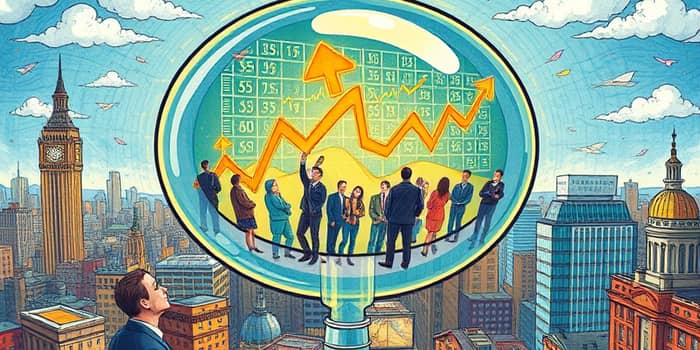Market bubbles have recurred throughout history, fueled not solely by economic fundamentals but by the complex interplay of human emotions. From the Roaring Twenties to the dot-com era, investors repeatedly find themselves caught in cycles of euphoria and panic. By examining the anatomy of bubbles, the psychological biases at play, and the quantitative signals that warn of danger, readers can develop resilience and safeguard their portfolios against dramatic downturns.
Understanding Market Bubbles
A market bubble occurs when asset prices rise rapidly and well beyond their intrinsic value. These inflated valuations are driven by collective sentiment rather than underlying fundamentals. Bubbles only become apparent in hindsight—during the boom phase, skepticism is often dismissed.
Charles Kindleberger’s classic model breaks a bubble into five stages, each marked by distinct behaviors and market dynamics. Recognizing these phases can help investors identify when exuberance has eclipsed reason.
The Power of Investor Psychology
At the heart of every bubble lies a set of cognitive and emotional biases. Greed and fear form the twin engines of price swings: greed pushes valuations ever higher, while fear triggers mass sell-offs. Irrational exuberance and speculation often become the norm, overshadowing prudent risk assessment.
Key psychological drivers amplify herd behavior and distort decision-making. As more investors buy blindly, those on the sidelines experience fear of missing out, compelling them to chase gains despite rising risks.
- Greed and Fear: Fuel buying during booms and panic during busts
- Herd Mentality: Following crowds amplifies trends
- Overconfidence and Optimism Bias: Ignoring warning signs
- Loss Aversion: Selling quickly to avoid perceived disasters
- Confirmation Bias: Seeking bullish narratives while dismissing doubts
Lessons from Historical Bubbles
Studying past bubbles helps us appreciate the recurring patterns of boom and bust. In 1929, rampant margin debt and unchecked optimism led to the worst market crash in U.S. history. A similar story unfolded in the dot-com era, when the Nasdaq surged over 500% between 1995 and 2000, only to lose nearly 80% of its value in the subsequent collapse.
The Japanese asset bubble of the late 1980s saw the Nikkei index swell by almost 400% in four years, then tumble by two-thirds over the following decade. More recently, U.S. housing prices doubled from 2000 to 2006, only to drop more than 30% after the subprime crisis.
- 1929 Stock Market Crash: Leverage at record highs, widespread speculation
- Dot-Com Bubble (2000): Nasdaq P/E ratios above 100
- Japanese Asset Bubble (1985–1989): Nikkei up nearly 400%
- U.S. Housing Bubble (2000–2006): Home prices +100%
Quantitative Red Flags and Metrics
While psychology is crucial, objective data offers vital warning signs. Historically, extreme valuation ratios—Price/Earnings, Price/Book, and price/income—signal unsustainable runs. For instance, during the dot-com mania, P/E ratios on many tech stocks exceeded 100. In the housing market, price-to-income ratios reached unprecedented highs, foreshadowing distress.
- Valuation Ratios: P/E and Price/Book above historical averages
- Leverage Levels: Margin debt and subprime lending at peaks
- Sentiment Surveys: Excess bullishness and euphoric media coverage
Mitigating Risks and Building Resilience
Investors can protect themselves by establishing clear guardrails and disciplined processes. Embracing diversification and disciplined rebalancing helps reduce exposure when markets become overheated. Regularly revisiting portfolio allocations prevents undue concentration in any single asset class.
A skeptical mindset is essential. Question narratives that claim "this time it’s different" and verify investment theses against historical precedents. Maintain a margin of safety by setting predefined exit rules and staying attuned to shifting market conditions.
Cross-Cultural Perspectives and Conclusion
Investor psychology varies across regions. Some cultures exhibit stronger loss aversion, while others display a higher tolerance for risk. These nuances shape the intensity and duration of bubbles globally, from European property markets to emerging-market equities.
Ultimately, market bubbles remind us that financial markets are as much a reflection of human nature as of economic data. By combining rigorous analysis with an awareness of personal cognitive biases, investors can navigate the cycles of boom and bust with greater confidence. Staying informed, maintaining discipline, and learning from history are the best defenses against the next inevitable bubble.
References
- https://russellinvestments.com/content/ri/us/en/insights/russell-research/2024/05/bursting-the-myth-understanding-market-bubbles.html
- https://www.investopedia.com/articles/stocks/10/5-steps-of-a-bubble.asp
- https://realinvestmentadvice.com/resources/blog/market-bubble-a-function-of-psychology/
- https://en.wikipedia.org/wiki/Economic_bubble
- https://www.ebc.com/forex/what-causes-a-stock-market-bubble-simple-breakdown
- https://www.broadridgeadvisor.com/kt/HtmlNL.aspx?pvw=B0DAD71E67383653C4D172D44B4207CB5C99F8F9FE07D228C5F4669BE64D8321BFE510414E340D6DDA446CB16D7AD38BFAF5ED7D2216F9E359A88A9CCC51EF9A2AD19AB31B02110BA4E31AC6E3D906C10995ED1747EC825850063432EED17ECB9A4C2FF48EF43AEE06A962CED6AAB3D9981D9F74739D46D6A8D40C124834FF7742D31F7126237C793597E60A7F0708B2
- https://substack.com/home/post/p-154536326
- https://www.toptal.com/management-consultants/financial-analysts/investor-psychology-behavioral-biases










